Riccitello on draft enforcement
During his 20-year stint as a pro triathlete, Jimmy Riccitello was at the wrong end of many race marshal calls – and non-calls. Famously, he was leading the Mazda Orange County Performing Arts Center Triathlon where a big winner’s award – a Mazda Miata, $5,000 and a paid trip to the Goodwill Games in Russia – attracted a world class field. Coming into T2, Riccitello was leading by a defendable margin whereupon he unclipped his chin strap before he racked his bike and was disqualified. At the USAT Pro Nationals in Hilton Head South Carolina, referees DQ’d him for crossing the yellow line by inches, even though he had to swerve to avoid a crash. Riccitello also missed out on other paydays when men ahead did not receive draft calls that the future Ironman head ref believed were well deserved.
In 2005, Riccitello was hired by Ironman to take on the big job of head marshal for its biggest events. What they got was a man of great experience, particularly as an expert cyclist, intelligence, a fierce sense of fair play and a great deal of empathy for the athletes – pro and age group alike. Still, while improvements continue to be made, the business of drafting enforcement remains a complex equation in which perfection and absolute fairness remain an impossible dream.
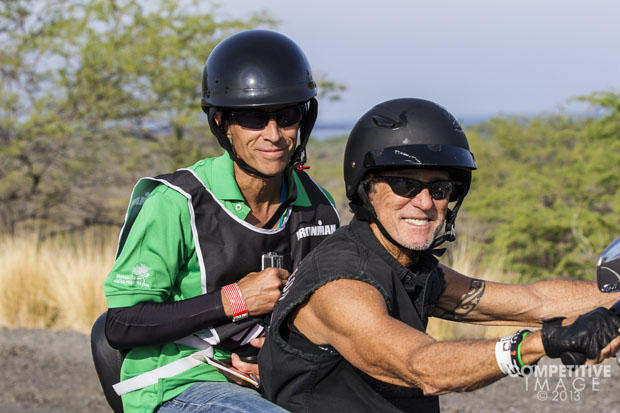
After a bad day at Ironman 70.3 Worlds and a relatively good day at Kona, the chief draft honcho was faced with a not uncommon barrage of criticism. Here Riccitello submits to a Slowtwitch Q&A in an attempt to explain his thinking about this sacred task which attempts to defend the non-drafting aspect of triathlon as an individual competition on a level playing field.
Slowtwitch: When did you start officiating?
Jimmy Riccitello: In 2005, I think – a few years after I stopped racing and began coaching. IRONMAN wanted to minimize drafting, minimize post-race bickering over drafting and other rule violations, improve the quality of officiating, and remove the “us against them” mentality that existed at the time. After talking with IRONMAN, I felt that this was an opportunity for me to make a difference.
ST: After all your experiences as a pro, why do you feel inspired to have this thankless job?
Jimmy: It’s not a thankless job. It is just that unhappy athletes are more vocal than the happy ones, but I get some thank yous. Many people are happy that there is less drafting in IRONMAN events than when I started, and they’re grateful that we are making a strong effort to tackle a tough problem. I am inspired because I raced triathlons for 20 years and understand very well that drafting is a tough problem to fix. I like a challenge.
ST: After this season, there seems to be a number of long-term issues concerning draft enforcement fairness at races around the globe. As Ironman’s head draft marshal, is there one big misconception you would like to clear up?
Jimmy: There seems to be this notion among certain people that IRONMAN doesn’t care about drafting. Due to my limited skillset when I was racing (decent swimmer/above average cyclist/penguin-esque runner), I despised athletes who blatantly drafted – and yes, there was blatant drafting in 1985 – and pushed for quality officiating and intelligent and effective rules. But I also put my money where my mouth was, and spend six years on the USAT Board of Directors to be part of the process leading to solutions. IRONMAN cares about drafting and is dedicated to continuing to find new solutions to decrease drafting.
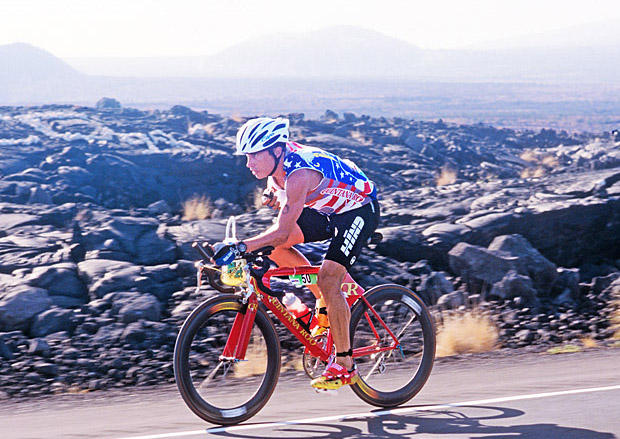
ST: So did Ironman ever urge you to take it easy on the customers?
Jimmy: No. The opposite is true. They want me to make a difference. It’s just that drafting is a very complicated issue. It’s not an easy issue to control, and it never will be.
ST: Is your statement that this is a “complicated issue” a cop out? Should the people who hate drafting give up hope?
Jimmy: No. It’s not a cop out. Anyone who’s done a crowded, competitive triathlon knows that drafting is complicated and difficult to police. But it’s an issue that can be put under control. There are several keys to minimizing drafting: First, you need to be mindful of how you start athletes in the swim because how you start athletes determines how they come out of the water and flow onto the bike course. Second, you need to enforce the rules and this means an increasing level of scrutiny – primarily by providing more draft marshals and educating the athletes on how you are going to marshal the race. Thirdly, you need to continue to change the mentality of the athletes from “I’m going to draft because everyone else is drafting,” to “I’m going to do the right thing whether someone is watching or not.”
ST: Do you really think you can convince the pros and the masses to resist the urge to cheat?
Jimmy: Yes. First and foremost, the culture of triathlon is one that celebrates individual effort and fair play. So we are fortunate to have that as a starting point. But within a race, by providing more draft marshals, and educating the athletes about the rules, you will reinforce to the athletes that doing the right thing will not negatively impact their race. In other words, we need to continue to instill confidence in the athletes that the majority of their peers are doing the right thing. One way we can do this is by having a large enough presence on the course so that the athletes understand that the majority of their peers are being monitored.
ST: So how have you gone about this Sisyphean task?
Jimmy: We’ve been working closely with the ITU to develop a global set of rules for “long-course” triathlons such as our 70.3 and IRONMAN distance events, since many of our events are sanctioned by National Federations that use the ITU rules. We’ve also been working closely with USAT to discuss changes to their rule book in an effort to get it closer to the ITU’s in some areas. We’ve been making excellent progress there and, until and if changes are made, USAT has granted us rule amendments that allow our races to be run with a rule set that is closer to the rules used in our non-USA events. I anticipate a few changes to our rule book for 2015 that will build on some of the successes we’ve had up to this point.
ST: What changes have you done to this point?
Jimmy: Up to this point, we’ve been focusing our efforts on decreasing bike course density and increasing the number of referees on the course. Increasing the number of referees on the course has been difficult at some venues due to limited availability of certified officials or safe motos, but we’re making steady progress – especially abroad. We’ve also instituted time trial swim starts and rolling swim starts. We’ve implemented wave starts at events that have historically been mass start swims. This year Kona had separate waves for pro men, pro women, age-group men, and age-group women. Finally, as mentioned earlier, so that we can get our USA events closer to the International standard, we’ve asked for and been granted permission by USAT to amend their rules as follows for our USA events:
• use a longer draft zone than what USAT Rules currently specify,
• use a colder wetsuit-legal water temperature limits for age groupers in an effort to have fewer wetsuit legal swims, spreading the swim out a bit.
• prohibit non-textile speedsuits in an effort to spread out the swim in non-wetsuit legal swims,
• notify athletes on the spot, when rule violations are observed, and send them into a penalty tent on the field of play, thereby affecting a group of drafting athletes versus writing down numbers and applying penalties after the race – which has very little effect of reducing the size of groups during the race.
ST: What do these actions prove?
Jimmy: These are not the actions of a company that doesn’t care. There are still some races that have more drafting than we would like. My marching orders are clear: make significant progress in this area in 2015.
ST: So what do you say when certain events produce many complaints of drafting?
Jimmy: I understand that perception gets skewed every time we fail. So I try to minimize our failures and continue to push for global rule harmony, and to work towards getting referees and event directors at all of our almost 200 events on the same page. We’ve made huge strides to this end in 2014.
ST: There was a lot of frustration about drafting at Ironman 70.3 Worlds in Mt Tremblant.
Jimmy: I know. I was there, and it was not our finest hour. I was bummed and promised Andrew [Messick, Ironman CEO] that we would get it right at Kona – and we did.
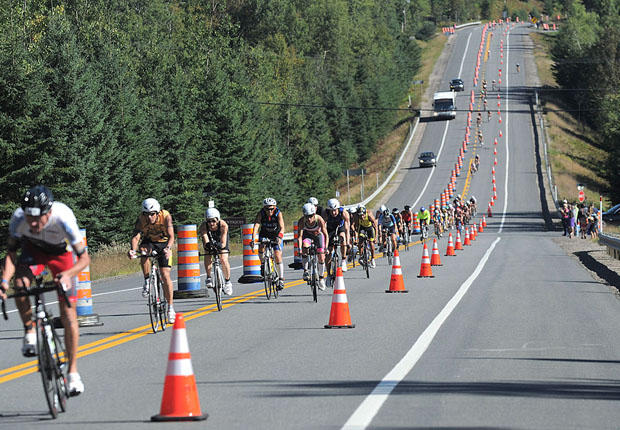
ST: What led to the complaints?
Jimmy: There were a number of factors – primarily the lack of space to safely position a moto to the left of the athletes. We could not safely marshal several sections due to the width of the roads. We underestimated at Tremblant the impact that the course design would have on the ability of the draft marshals to safely and effectively police the event.
ST: There was some drafting among the pros – Helle Frederiksen was given 4-minute penalty – so how well did your marshals call the race?
Jimmy: I was happy with the pro race in Mt. Tremblant. We did well with what we had. The pros have embraced our system and seem trusting that the draft zone and specifics that relate to passing, slotting in, etc. produce the best swim/bike/runner on the day. The majority of the pro athletes are righteous.
ST: With 2,600 age group competitors in a 56-mile bike course, crowding makes drafting inevitable. How is it possible for so many entries to avoid drafting?
Jimmy: That is not correct. Blatant drafting is always a choice. Even in a big race with lots of top athletes, you can always ride clean, especially as an age grouper. A couple of things to consider: first – all of our 70.3 events have wave starts which help to spread the race out. Second – the swim mixes things up enough that the crowding is typically temporary. There are good swimmers who are poor cyclists, poor swimmers who are super cyclists, and other combos. So there are usually spots on the course where the athletes temporarily converge, and part of the trick to successful draft marshaling is to both predict where the convergences happen, and to provide adequate staffing so that if you predict incorrectly, you have enough of a presence that it doesn’t matter so much. We collect data for all of our events, and this helps predict where the density will happen. I guess what I’m trying to say, is that there is an art to draft marshaling, which is kind of cool – especially when you get it right.
ST: One commenter on our Slowtwitch race story wrote with certainty that Javier Gomez was “warned” three times but given no penalty. True? Grouch without facts?
Jimmy: That is baloney. I was near Gomez for much of the race and never saw him break a rule. Our referees are impartial and call penalties dispassionately. There is not a shortage of big-name athletes receiving penalties. Go back and check the record – we have never been hesitant to penalize prominent athletes.
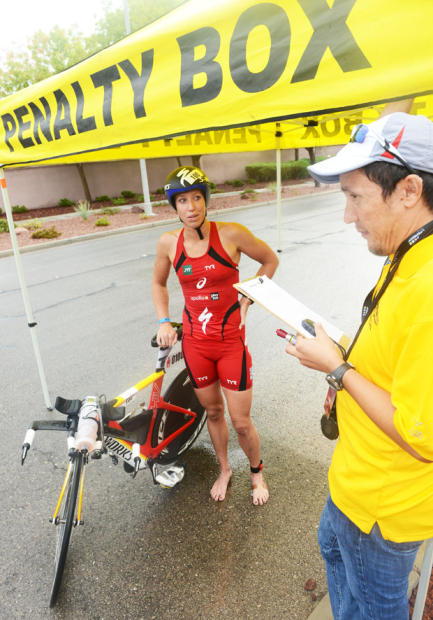
ST: Has there been an improvement in self-regulation among pro athletes in the last five years? If so, why?
Jimmy: Over the years, the pros have taken ownership of the rules. Because so many of them follow and trust IRONMAN rules, we have a situation where those who choose not to play by the rules stick out like a sore thumb. The fact that the pros are currently trusting that we will nab the offenders makes our job a lot easier. I consider our biggest victory with regard to the enforcement of the pro draft rules is that the overwhelming majority of pros choose to do the right thing – regardless of whether or not a draft marshal is riding beside them. This choice is contagious.
ST: Back in the day, amateur marshals at Ironman Hawaii were described as talking to the pros and warning them after they were observed to be drafting that they had one minute to leave the draft zone. As I understand, when USA Triathlon chief marshal Charlie Crawford was put in charge at Kona in 1996, he directed the marshals not to communicate with the riders, but give penalties when violations were observed. You mention that you want your marshals to be a bit proactive and communicate with the evolving packs to urge them to be careful to avoid penalties. Can you elaborate what is the proper line to hold on this delicate matter?
Jimmy: Charlie and I have different styles, but I’m certain that we both want a fair and safe race. Other than to notify an athlete of a penalty, I ask that communication between marshals and athletes be kept to a minimum, and be very purposeful. I do not advocate warnings such as, “If you don’t stop drafting, I’m going to give you a penalty.” However, I do advocate being proactive. An example of being proactive would be to notify athletes who are riding the proper distance to not get any closer for the rest of the race. A referee could say, “Looking great – no closer than this all day and you’re good.” This lets the athletes know that they’re safe, but should not get any closer. If, however, a referee happens upon athletes riding within the legal distance for longer than the allowed time, referees are instructed by me to immediately penalize the athletes.
ST: Given that it is crucial not to leave draft calls to a post-race debate – so the winner will not be decided after crossing the line – how is making calls in mid-race working?
Jimmy: We have very little post-race debate with our system. Notifying an athlete of their rule violation, on the spot, leaves very little doubt about what they did wrong. By the time the athlete finishes his/her penalty, they’ve typically accepted responsibility for their mistake. If they continue to stew, it’s usually due to their perceived arbitrariness of the call. In other words, they know that they made a mistake, but are pissed that others didn’t get called, too.
ST: How do you make sure that there is no draft zone shrinking?
Jimmy: Encouraging referees to be patient yet attentive to blatant rule violations starting at mile one of the bike. If you set the tone early, the athlete’s level of expectations regarding rule enforcement remains high throughout the race. In addition, since I started this job, I’ve been experimenting with ways to make the draft zone as objective as possible. I’ll take credit for pioneering the use of the road markings to help officials and athletes get on the same page with respect to the draft zone. In the USA, the DOT regulations require that the broken lines in the middle of the road are 10 feet long and the space between the broken lines is 30 feet long, or approximately 10 meters. These markings are used by referees to help judge the draft zone, and I encourage athletes to also refer to the road markers.
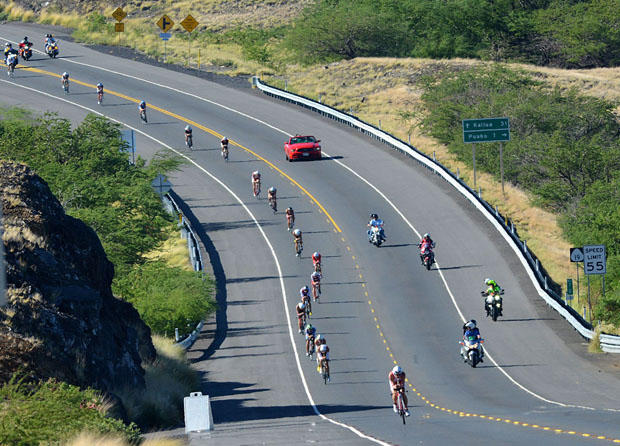
ST: Within the rules, what are some of the judgment calls a modern draft marshal should make? Do they have leeway? Or should marshals just be hard-ass robots?
Jimmy: By definition, all of the position rules – drafting, blocking, etc. are judgment calls, even though the rules are written to be black and white. So there’s obviously some leeway. Unlike robots, Referees have a brain and I hope that they use judgment when determining whether or not an unfair advantage has been gained.
ST: Now the Ironman 70.3 Worlds will move a continent away and they won’t host the next 70.3 World Championship. What can you do to make it right the first time? Do any of the lessons of Mt. Tremblant carry over to the next race in Austria?
Jimmy: I learned a lot from Mt. Tremblant. Mainly, I need to have a complete understanding of what the course will look like on race day – how wide the lanes are, exactly where the cones are placed, the order of wave starts, and I need to spend a lot of time educating referees that I’ve never worked with, on our expectations with regard to rules and rule enforcement. I met with the organizers of the 2015 IRONMAN World Championship in Zell Am See, Austria while I was in Mt. Tremblant. For 2015, we are guaranteed a sufficient draft marshals, a completely closed course (zero cars) and a big-ass hill.
ST: What does an experienced, intelligent triathlete realize about the complexity of draft regulation that many shoot-from-the-lip commenters do not take into consideration?
Jimmy: People generally think that managing the bike course is easier than it really is. People say, “How hard can it be?” Harder than they think.
ST: Back to basics – how long are triathlon race bikes from center wheel to center wheel? And how long are they from the outside front tire to outside rear tire?
Jimmy: Bikes are about 1 meter from center wheel to center wheel, and about 1.7 meters from outside front tire, to outside rear tire.
ST: So how many bike lengths – outside of front wheel to outside back wheel – are there in 12 meters?
Jimmy: A tad more than seven bikes fit inside 12 meters. So that makes the pro draft zone 6 bike lengths since the draft zone is taken from front wheel to front wheel. The IRONMAN age-group draft zone is currently defined as 7 meters BETWEEN bikes, or about 4 bike lengths.
ST: What are some of the basic differences between USAT no-draft rules and ITU no-draft rules?
Jimmy: The current USAT draft zone is 7 meters from front wheel to front wheel, or about 3 bike lengths between bikes. The current ITU pro and age-group draft zone is 12 meters from front wheel to front wheel or 6 bike lengths between bikes [same for Ironman].
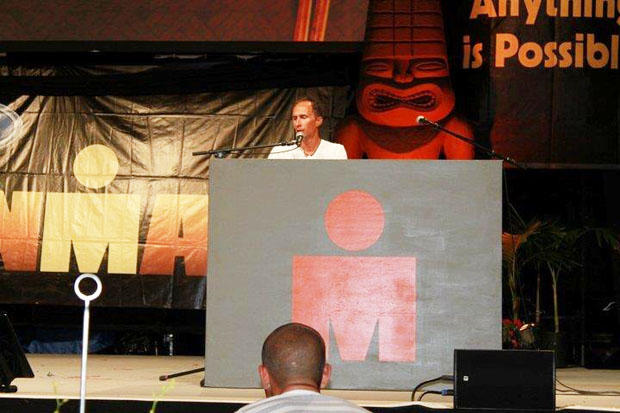
ST: Do you see a role for hi-tech gear to help call the races like Go Pros in cop cars? Or GPS recordings of the distances between riders? Will your job ever be automated?
Jimmy: Not any time in the near future. There is a lot of history in trying to bring technology into sports officiating. It has proven vastly harder and slower and more complicated than people originally predicted. There is a reason that football, basketball, soccer and baseball have very limited use of technology for officiating. It seems initially inviting but you open the door to all kinds of other problems.
ST: Watching Challenge Bahrain, their 20 meter rule seemed to work for the pros. Is that a good idea? What would that be like at Kona or other more crowded WTC races?
Jimmy: I like the idea of a 20 meter draft zone, and it appeared to work great there. However, I don’t think it can work in a Kona type pro field where you have 30 guys coming out of the water together, or on a Kona type course. But I’m watching.
ST: You seem to be open to listening to heated complaints. Why do you listen?
Jimmy: I’d be a liar if I didn’t say that listening is occasionally frustrating. But the fact is that listening is a big part of my job, and I learn a lot by listening. I learn a lot about our system, from the athlete’s point of view, about our referees, the rules, the behavior of athletes, athlete’s perceptions of our system versus reality, and our effectiveness – to name a few. It’s not all helpful, but if you’re willing to listen – more often than not, you’re going to come away from the conversation a better referee.
ST: What was the worst day for drafting you’ve experienced in a major race?
Jimmy: Clearwater [Ironman 70.3 Worlds] in 2006 was the worst that I’ve seen. The course was way too narrow, and simply did not allow us to monitor drafting, and made it nearly impossible for the athletes to do the right thing. Even when athletes were two abreast, when passing it was so narrow that athletes behind the two passing athletes were prevented from advancing. After a certain point, no one could pass, and we could do nothing to remedy the situation. The majority of the bike course was in the median lane – the far left hand lane, and it was impossible to safely drive to the left of the athletes and monitor the race. There was traffic in the lanes to the right of the athletes which prevented us from marshaling from the right side. It was a recipe for disaster. We did our best, but were horribly ineffective.
ST: What were some of the circumstances when the top men and women pros – including Jan Frodeno and Mary Beth Ellis – were given 4 minute calls this year at Kona?
Jimmy: As far as the pro calls: most of the penalties were given for breaking a part of the rules that encompass drafting – taking too long to pass, or pulling in between two athletes who are properly spaced, as opposed to blatantly drafting. There are very few penalties given in the pro field. The main reason for this is that the world is literally watching. No one wants to be seen breaking a rule – especially drafting. Additionally, on the white line that separates the shoulder (breakout lane) from the road, there are reflectors every 12 meters from mile one to mile 112. This makes the Kona pro draft zone very objective, and very obvious. The course runs north and south, so shadows are perpendicular to the athletes which makes it very obvious to anyone watching, when someone rides into the draft zone of another athlete. All of these things make the pro race in Kona very fair and I feel the best swimmer/biker/runner on the day is winning the race. The fact that Mirinda and Sebastian won, and the manner in which they won, is indicative of this.
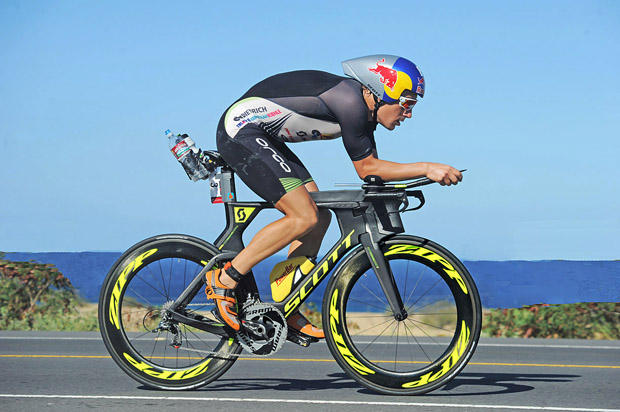
ST: Do wind conditions make draft calls more or less likely?
Jimmy: The wind makes a difference both ways. Our efforts in Kona were helped tremendously by the wind this year, which blew from the side for most of the race. This isolated the riders, made it very hard to gain a benefit while riding at the legal limit of the draft zone, and made it easy to spot those trying to gain an unfair advantage. As a result, most of the 231 penalties were the result of blatant drafting, versus being a victim of circumstance. When I say blatant drafting, I mean most of the age-group calls were made on athletes who rode WELL within the draft zone for more than 20 seconds, and not on athletes who took too long to pass, or entered the draft zone and then backed out before passing.
ST: How do you respond to photos that look incriminating or appear to dispute claims that a race doesn’t have much drafting?
Jimmy: It’s hard to judge drafting from a snapshot. The primary reason for this is that the race is dynamic – athletes are often passing and/or being passed. Per the rules, draft zones can intersect when passing. Therefore it’s very hard, looking at a moment in time, to tell if someone is riding into the draft zone as they pass, or are in the process of backing out of the draft zone after being passed. My point is that many of the situations that photos represent are very temporary – athletes sorting themselves out after an aid station or on a hill. Also, a camera lens can distort distance, making athletes look closer than they are in reality. Going back to the road markers, however, critical thinkers can use the road markers and shadows from the athletes, to judge distance. Looking at the pictures you sent me of the pros in this year’s Kona event and using the 30 foot space between the broken lines in the middle of the road or the reflectors on the white line that separates the shoulder from the road (40 feet between reflectors) for reference, it’s clear that they’re respecting the 12 meter draft zone. This said, I accept the fact that a picture may be documenting a group of purposeful drafters. It’s just that it’s wrong to make that assumption unless you’re there to witness that specific situation play out.
This particular picture, it should be noted, was taken right after an aid station. The rules specify that drafting calls should not be made right before, during and immediately after an aid station. The purpose is to allow the athletes some room to sort things out right after the confusion and congestion that occurs in aid stations.
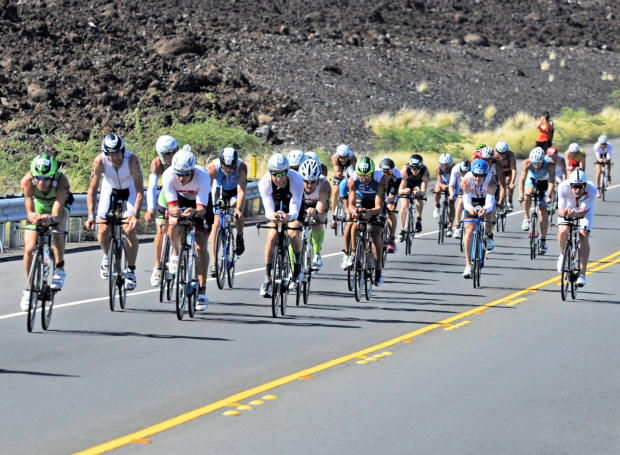
ST: Anything else you would like to mention?
Jimmy: This interview is a good example of what frustrates me somewhat, about the way drafting is reported. You asked a lot of questions about 70.3 Worlds, but only a single question about Kona, where we were extremely successful, and none about other events that have seen huge improvements over the last few years. I get a few kudos from some of your commenters, which is great because they participated in the event and saw improvement or minimal drafting, but the media rarely calls me up and says, “Great job on that race, Jimmy. I didn’t see any drafting.


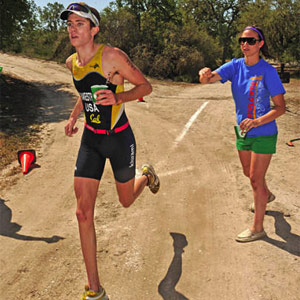
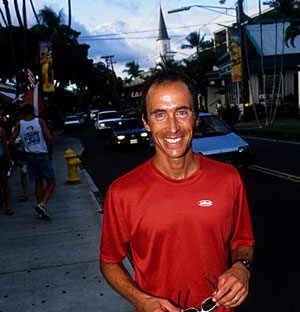
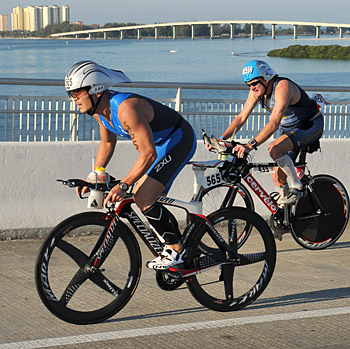
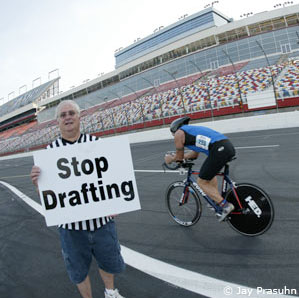
Start the discussion at slowtwitch.northend.network